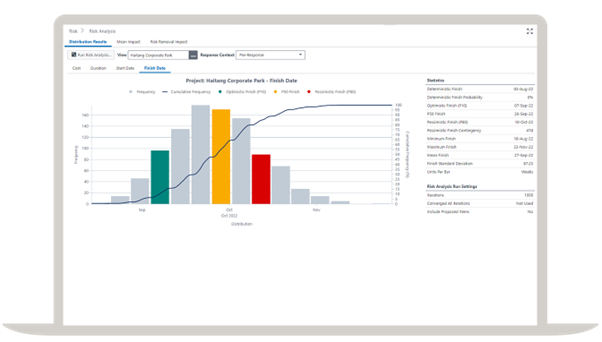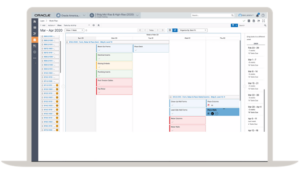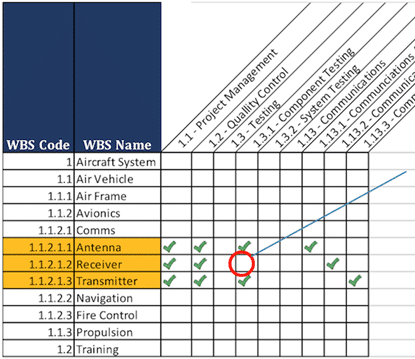
In a world where projects are becoming increasingly complex, effective project management is essential for success. As your trusted partner in advanced project management, BAEKEN uses Oracle Primavera Cloud (OPC) to provide insight and control in high-tech innovations, energy transition, area development, and infrastructure projects. In this article, we will show you why and when you should consider OPC for your projects.
OPC is a comprehensive, cloud-based project management suite designed for large and complex projects. It serves as the cloud-based successor to the well-known on-premise Primavera P6 solution.
Whether managing individual projects or an entire project portfolio, OPC offers the tools to oversee projects from start to finish. This enables efficient planning, stakeholder alignment, monitoring, and optimization, with a strong focus on time, cost, and risk management.
Unlike Primavera P6, which requires extensive network configurations and periodic local updates, OPC eliminates the need for maintaining servers, networks, and manual updates.
You should consider OPC when starting complex projects involving multiple stakeholders, where time and cost control are crucial. At the launch of a new project, OPC is an attractive option because it allows for rapid implementation with minimal setup time.
Even if your project is already underway, switching to OPC can be beneficial, especially if you’re currently using Excel, Microsoft Project, or other limited software solutions. Beyond just data migration, Primavera solutions provide greater control over scheduling, offering the project team more realistic and actionable insights.
If you’re interested in data migration or need guidance on restructuring your PMO, feel free to reach out.
OPC is particularly suited for industries like construction, energy, and infrastructure, where precise planning and risk management are essential. It also offers integration capabilities with other systems and data analysis platforms, enabling seamless workflows and better project performance insights.
1. Data-Driven Project Control
At BAEKEN, we optimize project performance with detailed data analysis in OPC. The platform makes it easy to collect, verify, and visualize project data, ensuring full transparency on project status. This aligns with our core value of analytical excellence, turning data into valuable insights for better decision-making.

2. Enhanced Collaboration & Stakeholder Management
At BAEKEN, we believe in strong, long-term partnerships with all stakeholders. OPC simplifies collaboration by providing real-time access to critical project information for both internal teams and external stakeholders. This not only improves communication and transparency but also enhances alignment and proactively resolves conflicts.
3. Risk Management & Probabilistic Planning
One of OPC’s unique features is its ability to integrate risk management into project planning. With BAEKEN’s expertise in OPC, we help manage uncertainties in scheduling while maximizing opportunities. Probabilistic planning enables teams to model scenarios and make accurate predictions about the impact of potential risks.

4. Scalable & Future-Proof
Whether managing a small project team or a global network of stakeholders, OPC is scalable and can adapt to the needs of any project. Its cloud-based infrastructure ensures flexibility, growth potential, and access to continuous innovations in project management.
5. Lean Planning: Seamlessly Integrated with OPC
In many traditional planning environments like Primavera P6, Lean planning is often handled separately (e.g., manual sticker boards). With OPC, this fragmented approach is eliminated. The Lean module is fully integrated within OPC, providing a structured and visual overview of daily activities, leading to a more flexible and streamlined project execution.

For years, Primavera P6 has been the gold standard for planning software in complex project environments. It remains a powerful and reliable tool for project planning and control. However, its outdated interface and steep learning curve limit usability for non-expert users, such as stakeholders and execution teams, who need clear visibility into project planning. Additionally, P6 requires on-premise hosting, which demands IT infrastructure and maintenance.
This is where OPC becomes the modern, cloud-based successor to P6.With OPC, you not only get the same powerful planning functionality, but also a modern, user-friendly interface that is equally accessible to stakeholders and implementers, and the flexibility of a cloud-based environment. Furthermore, OPC is not just a planning tool like P6, but a project management tool that also integrates many other modules such as risk, cost, lean planning and portfolio management.
In short, Oracle Primavera Cloud is now truly ready for the future of project management. It combines the strong foundation of P6 with the modern technologies needed to successfully manage projects in today’s time.
At BAEKEN, we believe in delivering sustainable solutions that fit the ever-changing world. Our expertise in Oracle Primavera Cloud allows us to master not only the technical aspects of project management, but also the human side. We understand that every project is unique, and we apply OPC in a way that supports your specific goals, with attention to innovation, sustainability, and stakeholder relations.
OPC helps us deliver on our promise: To enjoy creating support and insight to create impactful projects successfully.
With our deep knowledge of project controls, complemented by the powerful tools of Oracle Primavera Cloud, we ensure that projects are completed successfully, on time, and on budget.
Oracle Primavera Cloud is not just another tool; it is a solution that builds on Primavera P6 and contributes to the strategic goals of organizations. At BAEKEN, we combine our expertise in Project Controls with OPC’s innovative capabilities to deliver sustainable, successful projects.
Are you ready to take project management to the next level? Contact us and find out how OPC can transform your next project.
Want to know more about this topic?

At BAEKEN we understand that the key to successful project management lies in the combination of technical expertise, strategic insight, and empathetic collaboration. That is why we have developed an intensive two-month training program aimed at training the next generation of Project Controls Consultants.

The training program is designed to develop the following core competences:

How We Teach
At BAEKEN, we believe that learning is most effective when it is approached from different angles. That is why we have developed a varied approach to educate participants in the different aspects of project management:
This combined approach ensures that participants not only acquire the knowledge they need, but also the practical skills to apply that knowledge. It is a holistic approach to education that prepares then to participate in real-world projects with confidence and competence.
Guidance and Application
After completing the training program, each participant will have the opportunity to apply the newly acquired skills in a real project. Under the guidance of an experienced mentor, you will receive intensive guidance during the first 6 months. But the training process does not stop after 2 months; at BAEKEN we always invest in development. Knowledge sessions are held regularly, and advanced modules are offered after some practical experience. This ensures a smooth transition from theory to practice and provides a safe and continuously evolving environment in which to learn and grow.
Conclusion
The BAEKEN training program is more than just training; it is an investment in the future of project management and an ongiong commitment to professional growth. Through a holistic approach to technical, analytical, and social skills, the program prepares individuals to make an impactful contribution to complex projects. With the support of experienced professionals, a focus on continuous growth, and a culture of continuous knowledge sharing and development, the Baeken training program is the ideal springboard for anyone who aspires to a career in project management.


One of the pillars of every project is the Work Breakdown Structure (WBS) and the associated WBS dictionary. Whether you are a contractor presenting the project baseline or the client reviewing it, the WBS and WBS Dictionary are your Rosetta Stone for understanding how the different pieces of a project will ultimately come together.

The WBS is the hierarchical subdivision of the project based on deliverables. It is the actual structure that we are used to seeing and using to organize the project. It allows us to break down the scope into manageable pieces and provides a reporting structure that we use for planning, performance monitoring, and actual costs.

The WBS Dictionary, in addition to expanding the simple description of the WBS elements, links the WBS to the Statement of Work (SOW). The WBS dictionary is usually a spreadsheet that lists the WBS, the WBS element name, and a description of the work in that element. A good dictionary will also have a field indicating which SOW paragraph is covered by that WBS element.

The last column in the example (Figure 1) shows how the lowest level elements of the WBS are related to the SOW. In the example, you can see that each element is related to two different sections in the SOW. This link demonstrates that the project will plan, execute, and capture actual project management costs with each individual element.
Linking these two structures allows you to view your project in different dimensions, which provides many reporting and analysis opportunities. It can quickly tell you whether you have everything covered in the SOW or are doing work in a WBS element that is not covered by the contract.
But that’s just the beginning. By looking at the relationships that exist between WBS elements in the schedule, you can see how different SOW paragraphs are linked and whether or not that makes sense. In addition, performance and actual costs can be assigned to SOW paragraphs. The visibility of this is even more valuable.
Used properly, the WBS dictionary becomes much more than a document describing work. It becomes a project kaleidoscope that allows you to view your project data in an infinite number of ways.
Understanding the WBS and the WBS Dictionary is essential to successfully managing a project. It provides a clear overview and in-depth understanding of how each part of the project comes together. It is a tool that should not be overlooked by project managers and stakeholders.


With every project comes risk, and that requires risk management. This is not just a task for the project manager, but for the entire team. It includes identifying, analyzing, and evaluating the risk and its potential impact.

A risk mitigation plan is not just a reactive document; it is a proactive approach to mitigating potential damage. At BAEKEN, we define risk events as those that could have a negative or positive impact on the project.
Risk identification is a layered and dynamic process. It involves not only identifying potential problems, but also creative and organized thinking. This includes brainstorming all possible risks that could negatively or positively impact the project.

Risks do not materialize in a vacuum; they can be tracked, understood, and evaluated. Checklists, based on previous experience, are a core part of the BAEKEN methodology and a valuable tool in identifying potential risks.
Risks are not all the same, and at BAEKEN we categorize them into areas such as technical, human, financial, and more so that we can thoroughly evaluate and manage them.
This statistical method goes beyond superficial calculations; it provides an in-depth simulation of possible outcomes and helps the BAEKEN team make accurate projections of risk events.
At BAEKEN, risk mitigation is not a standard practice; it is a customized strategy that considers various factors such as risk avoidance, risk sharing, and more.
We believe in flexibility and preparation. Our contingency plans are not mere back-ups but essential components for achieving project goals, even in the face of unanticipated risks.
